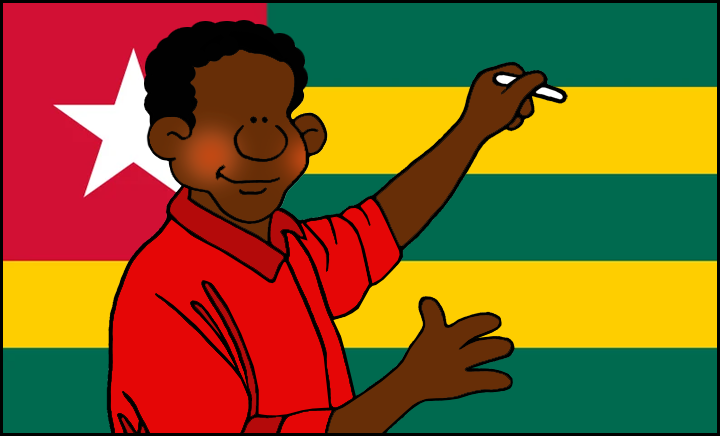Fun Facts about Togo
There are about 40 different ethnic
groups across Togo. The largest group, the Ewe, makes up about a
third of the population. The main languages spoken in Togo are
French, Ewe, Mina, Kabye, and Dagomba. The name Togo comes from
the Ewe language with the word "to" that means "river" and the word
"godo" that means "on the other side". Put the words together and
it means "on the other side of the river".
In the 1000s to 1500s, various tribal groups moved into the region of present-day Togo. From the 1500s to the 1700s, Togo was part of the Slave Coast in West Africa. In the 1700s, it was occupied by Denmark, and in 1884 Togoland was a German protectorate. During World War I, Togoland was taken control of by Great Britain and France. In 1956, British Togoland became part of the Gold Coast (now called Ghana). French Togoland gained independence from France in 1960.
The green stripes on the national flag represent the land while the yellow stripes are for mineral wealth. The red square stands for love, fidelity, and charity (or, if you look at other sources, it represents bloodshed for independence). Of course, the white star represents purity and peace.
The capital city, Lome, is considered one of the most beautiful cities in West Africa. It has been called the Paris of West Africa. However, the UNESCO Heritage Site located in Togo is in the northern part of the country. Koutammakou, a location with mud tower houses called Takienta, has become a symbol of Togo.
The Fazao-Malfakassa National Park, the largest of Togo's three national parks, is the home of 203 species of animals including birds, monkeys, antelope, and elephants. If you are more into the landscapes, you can also enjoy forests, savannah, cliffs, and waterfalls. Smuggling ivory is a problem across Africa wherever elephants are found. The record-breaking seizure of poached ivory in all of Africa took place in Togo in 2014. A total of 4.2 tons of ivory was seized, which represents about 380 elephants.
The favorite sport in Togo, is soccer (but, like most of the world outside of the United States, they call it football).
Food in Togolese cuisine consists of maize, rice, millet, cassava, yams, plantains, and beans. Maize is the most commonly eaten dish. If you ask what is the most traditional meal, there is a good chance that you will be told it's fufu, a cassava dish that is similar to Play-Doh and served with soup, stew, or a sauce.
People in Togo wear clothes similar to the kinds worn all over the world. If a woman wears traditional clothes, it is usually a long rectangular piece of fabric called a "pagne". A pagne is wrapped tightly around the torso and then flows freely. Traditional clothing for men can be the same kind of fabric, but it is sewn into matching shirts and pants.
Togo's economy is based mostly on agriculture. They grow coffee, cotton, cocoa, yams, cassava, corn, beans, rice, millet, and sorghum. The main industries include phosphate, marble, and limestone mining, as well as the production of cement and textiles.
In the 1000s to 1500s, various tribal groups moved into the region of present-day Togo. From the 1500s to the 1700s, Togo was part of the Slave Coast in West Africa. In the 1700s, it was occupied by Denmark, and in 1884 Togoland was a German protectorate. During World War I, Togoland was taken control of by Great Britain and France. In 1956, British Togoland became part of the Gold Coast (now called Ghana). French Togoland gained independence from France in 1960.
The green stripes on the national flag represent the land while the yellow stripes are for mineral wealth. The red square stands for love, fidelity, and charity (or, if you look at other sources, it represents bloodshed for independence). Of course, the white star represents purity and peace.
The capital city, Lome, is considered one of the most beautiful cities in West Africa. It has been called the Paris of West Africa. However, the UNESCO Heritage Site located in Togo is in the northern part of the country. Koutammakou, a location with mud tower houses called Takienta, has become a symbol of Togo.
The Fazao-Malfakassa National Park, the largest of Togo's three national parks, is the home of 203 species of animals including birds, monkeys, antelope, and elephants. If you are more into the landscapes, you can also enjoy forests, savannah, cliffs, and waterfalls. Smuggling ivory is a problem across Africa wherever elephants are found. The record-breaking seizure of poached ivory in all of Africa took place in Togo in 2014. A total of 4.2 tons of ivory was seized, which represents about 380 elephants.
The favorite sport in Togo, is soccer (but, like most of the world outside of the United States, they call it football).
Food in Togolese cuisine consists of maize, rice, millet, cassava, yams, plantains, and beans. Maize is the most commonly eaten dish. If you ask what is the most traditional meal, there is a good chance that you will be told it's fufu, a cassava dish that is similar to Play-Doh and served with soup, stew, or a sauce.
People in Togo wear clothes similar to the kinds worn all over the world. If a woman wears traditional clothes, it is usually a long rectangular piece of fabric called a "pagne". A pagne is wrapped tightly around the torso and then flows freely. Traditional clothing for men can be the same kind of fabric, but it is sewn into matching shirts and pants.
Togo's economy is based mostly on agriculture. They grow coffee, cotton, cocoa, yams, cassava, corn, beans, rice, millet, and sorghum. The main industries include phosphate, marble, and limestone mining, as well as the production of cement and textiles.
